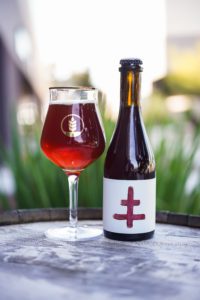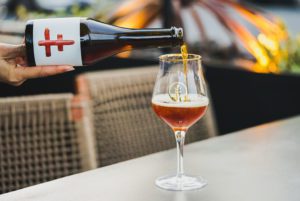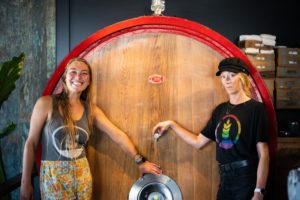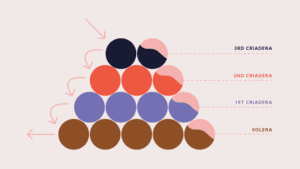The Story Behind Roes Red: The Wine of Beer
The Story Behind Roes Red: The Wine of Beer
Posted by Chris Leguizamon
4 years ago | August 17, 2021
Estimated Reading Time: 4 minutes, 47 seconds
AN ODE TO EUROPEAN TRADITIONS
Roes Red is our fresh take on a Flanders red ale, and a Great American Beer Fest medal winner at that! Flanders red ales have their origins in Belgium, dating back hundreds of years. We have blended this Belgian tradition with another adopted from the sherry producers on the Iberian Peninsula, the solera brewing method. Our new-world approach to both the solera system and Flanders styles of old, along with the addition of Pure’s proprietary yeast blend, means our Roes Red has a fascinating history and a delicious future.
THE BURGUNDY OF BELGIUM
Flanders red ale gets its name from its birthplace, the West Flanders region of Belgium, and its color is thanks to the Vienna and/or Munich malts it is built upon, which varies from deep red/burgundy to reddish-brown.
 The style is characterized by its complex fruit flavors (think black cherry, plum, orange and red currant), with mild vanilla or chocolate notes borrowed from the oak that it is aged in. It also displays varying degrees of sourness thanks to the oak barrels’ resident bacteria and the process of mixed fermentation, which preserves the beer by using acidity—a process developed before the days of refrigeration or pasteurization. Old beer is blended with fresh beer to balance the sourness and acidity.
The style is characterized by its complex fruit flavors (think black cherry, plum, orange and red currant), with mild vanilla or chocolate notes borrowed from the oak that it is aged in. It also displays varying degrees of sourness thanks to the oak barrels’ resident bacteria and the process of mixed fermentation, which preserves the beer by using acidity—a process developed before the days of refrigeration or pasteurization. Old beer is blended with fresh beer to balance the sourness and acidity.
While Flanders reds are not designed to hit you over the head with acidity and tartness, there is still a tannic bitterness that adds an aged red wine-like character. The result is a smooth, balanced beer that is often compared to red wine; the beer has even been called the Burgundy of Belgium.
Rodenbach Brewery, established in 1821 in the town of Roeselare, Belgium, was a pioneer of the style. Master brewer Rudi Ghequire says a good Flanders red should taste “perfectly balanced and have a refreshing-like quality to the taste.”
ROOTED IN ROESELARE
Roes Red, our Flanders-style red ale, is named after the Belgian town of Roeselare, where the style originated at the aforementioned Rodenbach Brewery. The label’s red double cross was inspired by the flag of Roeselare.
 Deep red-mahogany in color, Roes Red showcases bright cherry characteristics over a dark malt background with complementary sour lactic and acetic notes. But the complexity of Roes Red is really driven by our head brewer Winslow’s proprietary blend of yeast—Belgian in origin—containing multiple saccharomyces, brettanomyces, pediococcus, lactobacillus, and acetic strains. Following over a decade of selection, and surviving a fire in the cellar at the brewery where he used to work, this yeast has become its own unique blend designed specifically to work well in light-bodied, fruity red wine barrels. The first five batches of Roes Red were aged in French oak barrels that previously held pinot noir in Napa Valley.
Deep red-mahogany in color, Roes Red showcases bright cherry characteristics over a dark malt background with complementary sour lactic and acetic notes. But the complexity of Roes Red is really driven by our head brewer Winslow’s proprietary blend of yeast—Belgian in origin—containing multiple saccharomyces, brettanomyces, pediococcus, lactobacillus, and acetic strains. Following over a decade of selection, and surviving a fire in the cellar at the brewery where he used to work, this yeast has become its own unique blend designed specifically to work well in light-bodied, fruity red wine barrels. The first five batches of Roes Red were aged in French oak barrels that previously held pinot noir in Napa Valley.
Which leads us to batch #6…
 BATCH #6: THE BEGINNING OF AN INFINITE BLEND
BATCH #6: THE BEGINNING OF AN INFINITE BLEND
We mixed things up with our sixth batch of Roes Red—it was the first batch aged in our new 1,000-gallon Barolo cask from Italy, which you can find at our Carlsbad taproom. We call her Rosie. The aging process was initiated months prior with a 50/50 blend of fresh Roes Red and one-year-old Roes Red (batch #5). We emptied half of the cask and transferred it into bottles, then topped off the remaining half of the cask with another fresh batch of Roes Red. The beer went on to age for six months to a year before we bottled half of the new batch and called it batch #7. This process, called the solera brewing method, results in an infinite blend of all the batches that will ever be aged in the cask, including many years and vintages.
THE SOLERA BREWING METHOD
The solera brewing method, also called fractional blending, is a system of mixed fermentation that was originally used by Spanish and Portuguese sherry producers in the late 1700s. It’s a process for aging port, whiskey, brandy, marsala, balsamic vinegar, and, more recently, American craft beer.
The term solera is used to describe a system of aging in which batches of liquid are funneled into oak barrels or casks at various stages. Traditionally, the casks were arranged in horizontal rows with the bottom row, known as the solera (which stems from the Spanish suelo, meaning ground), containing the oldest liquid. When part of this is bottled, the casks are replenished with liquid from the row immediately above, which in turn is refilled with liquid from the next row, and so on. Today’s processes are not necessarily stacked physically in this nature, but carefully labeled. An example of a solera. Illustration credit: Danielle Grinberg. Image source: Vinepair
An example of a solera. Illustration credit: Danielle Grinberg. Image source: Vinepair
The solera brewing method is an excellent way to continuously make barrel-aged beer more quickly than conventional barrel aging. Similar to a sourdough bread starter, the untapped beer in the cask acts as a jump starter for the fresh beer that is added. The wild culture mixture slowly evolves over time and produces beer with some aged qualities that can be achieved in a fraction of the time.
Because the nature of the brewing process is unpredictable, we don’t know exactly when batch #8 will be ready. But we do know that the solera method is producing great depths of flavor and layers of complexity that wouldn’t otherwise be derived from a single barrel or batch on its own.
Beautifully intricate and delightfully refreshing, you can get your hands on Roes Red batch #7 here.
Plus, 2023’s fruited batch of Roes Red, which features organic black currants and figs is available now!
What is Flanders Style Beer?
Flanders style beer refers to a traditional type of sour ale that originates from the Flanders region of Belgium. These beers are known for their deep red color, which is achieved by using specialty malts, and their distinct tart flavor. Flanders red ales are aged in oak barrels for an extended period, which allows the beer to develop complex flavors including dark fruit, oak, and a vinous character.
What Makes a Red Ale Red?
The red color in red ales comes primarily from the types of malted barley used in the brewing process. Crystal malts and other specialty malts that have been kilned or roasted to develop certain caramel and toffee flavors, also contribute to the red hue. Additionally, the length of the boil and the Maillard reaction (a chemical reaction between amino acids and reducing sugars) can influence the color of the beer, giving it a reddish tint.





